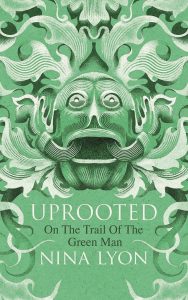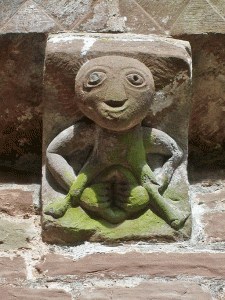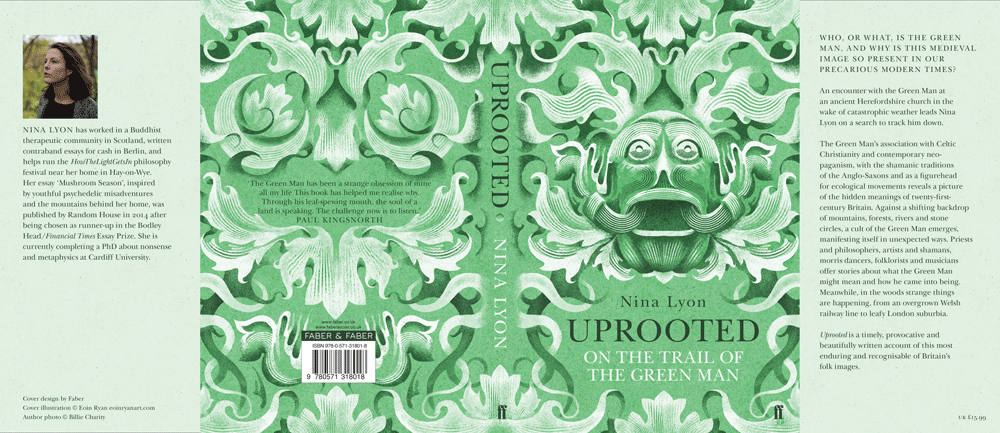WORDS: Gary Budden
 I spoke to author Nina Lyon about her latest book Uprooted: On the Trail of the Green Man (Faber, 2016), a brilliant piece of creative non-fiction about our attitude to nature and the environment, the resonance of the green man image and its current popularity, the growth of alternative thought and spirituality, and a lot more besides
I spoke to author Nina Lyon about her latest book Uprooted: On the Trail of the Green Man (Faber, 2016), a brilliant piece of creative non-fiction about our attitude to nature and the environment, the resonance of the green man image and its current popularity, the growth of alternative thought and spirituality, and a lot more besides
GB: First of all, thanks for agreeing to do the interview. I really enjoyed the book. I felt it was quite different to a lot of the other place and nature writing that is being put out at the moment.
I wanted to know a little about the genesis of the book – when did you become aware of the green man, when did you become interested in it, and how did that turn into a book?
NL: It happened completely by accident. I was trying to become an English teacher, and I was terrible at it. I had two very young children. I’d newly separated from their father. But I’d had this massive stroke of luck by winning an essay competition, and off the back of that I got an agent, and he said I should write something in that vein and let’s see if we can find a publisher for it. Then I had to find something to write about… When I wrote Mushroom Season, the essay, I had no idea that non-fiction was ‘a thing’. I didn’t know that nature writing was a thing.
G: And what was Mushroom Season about?
N: It was about magic mushrooms. I’m much more interested in magic mushrooms than I am nature writing, if we’re honest. I happen to be blessed by living in an area that is renowned for being very beautiful, and if you’ve got that in your backyard then it’s kind of obvious that you’re going to write about it. I didn’t intend to write about places, but I lived in those places and I was writing about experience. So I fell into it. What I didn’t realise was that you could then, under a vague-nature writing headline, get stuff published. So I was mindful that a bit of place-porn might be helpful in getting a book proposal accepted.
G: It’s very fashionable right now.
N: It is very fashionable. I think it’s a bit too fashionable at the moment. I think it’s important to write critically about place, and I think it’s important to use it as cinematography rather than the thing itself. There have certainly been times with my own writing when I’ve read stuff and thought ‘you know what? I ‘m just bashing out 300 words of place description here for no good reason’. We know that’s what we’re supposed to be writing at the moment.
Back to the book; I was bashing out book proposals which were terrible, and I was about to give up and go back to my PHD. But it was that winter of 2014, when we had those really insane storms. This year, the north got it badly, two years ago the Welsh borders got it really bad. I was really struck by how the weather had broken all of our sense of entitlement to an easy life. To be able to just drive down the road, to have central heating, to have electricity supplied. I was interested in that. I was interested in bits of speculative philosophy that I’d been learning about through my PHD, and the place that I would always visit when I wanted to clear my head was Kilpeck.
 G: Which is where you start the book.
G: Which is where you start the book.
N: The description in the book is pretty honest, as it happened. I went there to clear my head. Suddenly it all clicked – how would people perceive the winter we had just had 900 years ago?
G: Do you find the floods and the storms humbling; scary? It’s a reminder, perhaps, that human beings aren’t in as much control of the world as they may like to be.
N: Yeah. There was a thing about scale there, for me. We’re not very good at seeing strength, or agency, outside of our own scale. We’re stuck in the mindset of humanity, human progress and human institutions are where agency begins and ends. It seems to me that that’s nonsensical. A really good of example of that: people were up in arms about the fact that roads were closed, and surely we can do something about it. We came up the limit of our abilities there, and that was interesting.
G: It’s interesting what you say about the idea of human agency. There’s a part in the book where you talk about modern materialism as being (at the moment at least) more of a blip in terms of how humans have perceived the world. You mention speculative philosophy, including panpsychism. I found that really interesting; do you think this attitude to nature is a relatively new thing? There’s an argument that dates back only as far as industrialisation, to when the real schism appeared, viewing nature as other but with no agency.
N: I think that certainly in the Victorian era, as the post-Darwin technological materialism came in, there was an opposite reaction, a Romantic reaction – a slightly archaic ‘let’s back to nature’ reaction. I don’t think it’s an accident that The Golden Bough came out in that era.
G: I suppose the follow up question to that is: is the current interest and trend in nature writing a parallel/replaying of those feelings and reactions in the Victorian era? And that interest in what we can call alternative religions and a different kind of connection with nature?
N: I think it’s cyclical. And we’re deep in that part of the cycle at the moment…I don’t see the people around me in Wales reading nature writing as it’s just there on our doorstep. I think there’s an escapist quality to it and it tends to be something people read in cities.
G: It’s very popular in London…
N: Yeah. I think the phenomenal success of websites like Caught by the River really interesting. I’m pretty sure their demographic is mostly London.
G: In a way London is probably the worst place in the country if you want to get in touch with the things we’ve been talking about.
N: And yet these amazing patches of green wilderness in London. For example, where I live, we never see foxes (at least not alive). My kids fell in love with all the baby foxes you find sleeping on railway embankments, on the line into Charing Cross. There are these odd unexpected pockets, little strips of nature, that because of their geography – next to roads or railways – are pretty much untouched by people.
G: That’s covered a lot in ‘edgelands’ writing. You mention the forest near you that was planted very recently, sort of going against the fetishisation of ‘old growth’ woodland and so on. It brings us to the question of authenticity, something that is questioned a lot in the book. This is where the green man comes in – because no one actually knows exactly what it meant, it’s open for interpretation.
N: I never had much time for notions of authenticity. As soon as you try and fix down something as being more real, or more old, you usually find holes in that pretty quickly. When I first started the book it was proper gonzo writing; I knew nothing about the green man. I went in blind, and thought that might be interesting anyway. I went to interview an artist who lives near me – he’s now taken to creating green, living chapels – and he corrected me on many of my misconceptions. There’s this idea that there’s a tradition of what the green man is; that across different cultures there are all these analogues, but essentially it’s one thing. That’s a proper piece of wishful thinking.
People who are in touch with the green man want to tell this historicised story about it, because somehow it feels more real. So the next question was: why did we want that? How did we get to a point where people had taken it upon themselves to promote and believe an idea that the green man is essentially a pagan deity? That tells a lot more really interesting stuff about our culture now than any historical account.
G: Do you think the attitude of wanting to pin it down to one stable timeline is similar to the mentality found in Christianity? What I liked about the book is its advocating a non-dogmatic approach to engagement with these ideas. But there does seem to be a sub-section of people who want to find an alternative religion/deity, but then almost do the same thing with it as the religions they have rejected i.e. a fixed timeline, a strict interpretation.
N: The thing I really liked about ‘green-man-ism’ in its various forms is that is in anarchic. We have this set of associations: the green man as this Robin Hood-type character, a bit like the protagonist in Paul Kingsnorth’s novel The Wake. So what I think of as the Kingsnorth version of the green man is this woodland anarchic rebel. There’s also the spiritual ‘man interfacing with nature’ aspect of the green man. Neither of those things work well with the notion of organised religion, as they’re both about very personal forms of engagement. They don’t lend themselves to being institutionalised.
G: These symbols crop up a lot in different sub-cultures: folk culture, rave culture, and I really came to this stuff via the British punk scene (which seems odd to people outside of it). It seemed to be me to be an anarchic symbol representing ‘stepping out’ of everyday society in some way. I know there’s a link between the green man and the idea of subculture, but it’s very hard to pin down.
N: That’s really interesting. I don’t know what is either…I think the nature of any subculture that takes large groups of people out of mainstream society, and out of the culture sold to us by mainstream society, lends itself to this. If you look at the aesthetics of punk and psy-trance, they couldn’t be more different: but neither of them fit well into that culture of commodity.
G: And they’re both groups that have been ‘frowned upon’ shall we say…it always interested me that these kind of scenes and cultures often gathered in marginal spaces. The green man is a symbol I would see at these things, and I always wondered if people really understood its history or if it was more of an instinctive understanding. I’m not sure anyone was thinking ‘I’m going to worship the green man as a deity’ but it did seem to represent a kind of otherness.
N: It’s interesting to think about how much we consciously select images. When people get dressed in the morning they’re making a set of visual decisions. We don’t think very hard about it, but there’s often quite a lot of sophistication that isn’t entirely conscious that goes into ‘I like this image. That feels right’. So I think there’s a lot of visual sophistication in underground cultures, and we don’t give it much credit. In much the same way we don’t really know what the stone carvers at Kilpeck were up to, we don’t have a written history of it – but actually it was something pretty sophisticated. It’s just we don’t have a documentary verbal account that has a sophistication to match the visuals.

G: It is fascinating that green man figures, and Sheela-na-gigs, are on churches. I always found that strange. A co-option by the church, or people sneaking in their older/different beliefs into the church architecture?
N: I don’t know. It is really strange. The church story tends to be that they’re a warning against something i.e. the Sheela-na-gig is a warning against sex and the sins of the flesh. A way of making sex seem grotesque. Unfortunately, the one I saw was quite foxy with Princess Leia hair. But I really don’t know…I’d love to be a fly on the wall as those churches were being decorated. I guess you had to keep your congregation happy, didn’t you? Maybe you just wanted to make it as interesting and fun as possible.
G: I guess the point is we simply don’t know – which makes it strange people wanting to ascribe a rigid history to it.
I don’t know if you know the Hastings green man festival? That definitely had a lawless and anarchic feel to it when I visited this year.
N: I really wanted to get to that this year. I went to the Deptford Jack this year, it was really well attended. But it was quite well behaved. I’m definitely going to the Hastings one next year.
There is definitely a rebellious ‘fuck you’ aspect to some of the Jack in the Green culture; that came about in industrial society and probably didn’t exist before that. I think there’s room for a really interesting social history specifically about Jack in the Green.
G: It often gets conflated with the green man.
N: Yeah. It’s different.
G: You also visit Germany in the book, where they have a large number of green man sculptures. I was wondering if they were common in other parts of Europe too? Many people might think Scandinavia?
N: My understanding is that they’re mainly in this corner of north-west Europe. I don’t think there are that many in Scandinavia or the low countries. There are more in Germany than here, but that’s not surprising as Germany is a huge country. The kneejerk assumption that it would also be Nordic just doesn’t seem to be the case.
G: So it’s fairly culturally specific?
 N: In terms of the foliate heads on churches, they are restricted to this corner of north-west Europe. But I suppose each culture has its own sites of significance – the man/woman of the woods occurs in nearly every culture. I think that it’s just that this particular style of medieval architecture is common to our part of Europe.
N: In terms of the foliate heads on churches, they are restricted to this corner of north-west Europe. But I suppose each culture has its own sites of significance – the man/woman of the woods occurs in nearly every culture. I think that it’s just that this particular style of medieval architecture is common to our part of Europe.
G: You talk about how people in Germany don’t seem to care about the green man in the same way as they do in Britain. Why?
N: There’s something about British culture that has made us very receptive to neo-paganism. The historian Ronald Hutton describes neo-paganism as Britain’s great contribution to the religious world. We invented it here and it’s a very specific Anglo-American thing. I don’t know why it didn’t take off in other parts of Europe in the same way. My mum is German and I spent a lot of time in Germany as a kid, and I always felt that we’re basically German culturally. But this is one really significant difference. I don’t know if we have this romanticised notion of Arthurian England, of English faeryland? Around here there are lots of German hippies who moved to Western England who see this as the place where it all happens. Also the Church has held on a lot more in Germany than here. Parts of it are deeply Catholic. I think maybe we vacated Christianity much quicker and became more receptive to other ideas. I think in Britain there are a lot of people who want a spiritual story, just not one to do with organised religion.
G: Would it be fair to say the green man and associated images are a pre-Christian Anglo-Saxon symbol, but that’s been mixed in with Celtic imagery and romanticism? There’s a kind of faux-Celtic mysticism found in Britain that the green man gets lumped in with.
N: When we look at New Age culture, there’s a real love of Celtic woo woo (for want of a better term). You could do an interesting Venn diagram of people who use the green man and the Celtic knot and see what the overlap is. I bet it’s massive. So I think you’re probably right there. We’re so far removed from both any Anglo-Saxon or Celtic heritage that we cherry-pick bits of imagery from both that we lump together into our secret archaic history. We’re retrofitting all of those images into a fake historicised understanding of where they may have come from.
G: So do you find green men in Ireland?
N: I don’t think there are that many. The Sheela-na-gig comes from there, but I don’t think you find those kind of green man sculptures. Possibly just because that kind of architecture just wasn’t being built in Ireland then.
G: I like that phrase you used, woo woo. For me I came to this from a very atheistic anti-religion point of view (the punk scene). A lot of people would be very sceptical of this New Age spirituality, but at the same time wanting something spiritual and finding the green man a powerful image. How do you negotiate all this stuff and engage on your own terms?
N: It’s about how metaphorical you are. If you are able to see the green man as a metaphor for certain concerns or desires, or certain philosophical ideas, then it’s perfectly possible to enjoy it for what it represents without believing in some bloke in the sky who has horns and a green beard.
G: I mean it clearly exists in a form, in our imagination, as a symbol, in architecture. Do I literally believe? No, but that doesn’t seem that important.
N: It’s a way into thinking about the ideas that the symbol represents. I have a lot of time for that way of thinking; it’s surprisingly un-bonkers. I wouldn’t describe myself as a pagan or an animist, but by the end of the book I got it.

 ABOUT THE AUTHOR:
ABOUT THE AUTHOR:
Gary Budden is the co-founder of independent publisher, Influx Press and works as an editorial assistant for Unsung Stories. His fiction and essays have appeared in Black Static, Structo, Bare Fiction, Gorse, The Lonely Crowd, Under the Radar, The Learned Pig and many more. Click here to read his blog: New Lexicons.
For more birdwatching from Gary, check out Specifics: Thoughts on birds and birdwatching
You might also like his article Common Ground: Rob Cowen on Edgeland Literature, Psychogeography & Nature Writing







